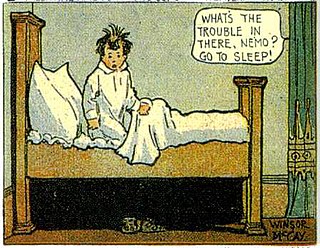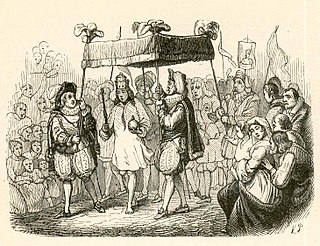
Fable is a literary genre defined as a succinct fictional story, in prose or verse, that features animals, legendary creatures, plants, inanimate objects, or forces of nature that are anthropomorphized, and that illustrates or leads to a particular moral lesson, which may at the end be added explicitly as a concise maxim or saying.

Little Nemo is a fictional character created by American cartoonist Winsor McCay. He originated in an early comic strip by McCay, Dream of the Rarebit Fiend, before receiving his own spin-off series, Little Nemo in Slumberland. The full-page weekly strip depicted Nemo having fantastic dreams that were interrupted by his awakening in the final panel. The strip is considered McCay's masterpiece for its experiments with the form of the comics page, its use of color and perspective, its timing and pacing, the size and shape of its panels, and its architectural and other details.

A fairy tale is a short story that belongs to the folklore genre. Such stories typically feature magic, enchantments, and mythical or fanciful beings. In most cultures, there is no clear line separating myth from folk or fairy tale; all these together form the literature of preliterate societies. Fairy tales may be distinguished from other folk narratives such as legends and explicit moral tales, including beast fables. Prevalent elements include dragons, dwarfs, elves, fairies, giants, gnomes, goblins, griffins, merfolk, monsters, talking animals, trolls, unicorns, witches, wizards, magic, and enchantments.

Baucis and Philemon are two characters from Greek mythology, only known to us from Ovid's Metamorphoses. Baucis and Philemon were an old married couple in the region of Tyana, which Ovid places in Phrygia, and the only ones in their town to welcome disguised gods Zeus and Hermes, thus embodying the pious exercise of hospitality, the ritualized guest-friendship termed xenia, or theoxenia when a god was involved.

Aladdin is a Middle-Eastern folk tale. It is one of the best-known tales associated with The Book of One Thousand and One Nights, despite not being part of the original text; it was added by the Frenchman Antoine Galland, based on a folk tale that he heard from the Syrian Maronite storyteller Hanna Diyab.

"The Emperor's New Clothes" is a literary folktale written by Danish author Hans Christian Andersen, about a vain emperor who gets exposed before his subjects. The tale has been translated into over 100 languages.

Uncle Remus is the fictional title character and narrator of a collection of African American folktales compiled and adapted by Joel Chandler Harris and published in book form in 1881. Harris was a journalist in post–Reconstruction era Atlanta, and he produced seven Uncle Remus books. He did so by introducing tales that he had heard and framing them in the plantation context. He wrote his stories in a dialect which was his interpretation of the Deep South African-American language of the time. For these framing and stylistic choices, Harris's collection has garnered controversy since its publication. Many of these stories are believed to have Creek Indian influence too.

Philip Craig Russell is an American comics artist, writer, and illustrator. His work has won multiple Harvey and Eisner Awards. Russell was the first mainstream comic book creator to come out as openly gay.
Janina Domańska was a Polish-born American artist, author and illustrator. She is best known for her self-illustrated children's books. She won a Caldecott Honor for her book If All the Seas Were One Sea in 1972.

Step Inside is a British children's television programme produced by Tricorn Productions for CBeebies in 2001 before the channel's launch, and aired between February and April 2002. It last reran in July 2010. There have been no VHS or DVD releases of the show, but all of the episodes have surfaced online apart from "A Bun for Barney".
Josepha Sherman was an American author, folklorist, and anthologist. In 1990 she won the Compton Crook Award for the novel The Shining Falcon.
Gerald McDermott was an American filmmaker, creator of children's picture books, and expert on mythology. His creative works typically combine bright colors and styles with ancient imagery. His picture books feature folktales and cultures from all around the world.
Alison Garrigan aka Alison Hernan is an American actress, singer, and costume designer, the daughter of actors Jonathan and Jo Farwell. She is well known for playing both male and female roles.
Anthousa, Xanthousa, Chrisomalousa or Anthousa the Fair with Golden Hair is a Greek fairy tale collected by Greek folklorist Georgios A. Megas in Folktales of Greece. Other variants were collected by Michalis Meraklis and Anna Angelopoulou.
David Hansen is an American playwright, actor, director and arts educator. He is the founder of Dobama's Night Kitchen and co-founder of Guerrilla Theater Company and Bad Epitaph Theater Company.

Saviour Pirotta is a Maltese-born British author and playwright who resides in England. He is mostly known for the bestselling The Orchard Book of First Greek Myths, an adaptation of the Russian folktale, Firebird, and the Ancient Greek Mysteries Series for Bloomsbury. His books are particularly successful in the UK, Greece, Italy and South Korea.

Tale Spinners for Children was a series of stories and novels adapted for young audiences on vinyl records in the early 1960s. They included a collection of old fairy tales, folklore, literary classics such as Don Quixote and Robinson Crusoe, and time-honored fables, with the title role sometimes played by a renowned theatrical actor or actress. The series gave children an exposure to timeless classic stories.

"The Gigantic Turnip" or "The Enormous Turnip" is a cumulative Russian and Ukrainian fairy tale, collected in Arkhangelsk Governorate and published in 1863 by folklore researcher Alexander Afanasyev in his collection Russian Fairy Tales, a collection not strictly Russian, but which included stories from Ukraine and Belarus alongside Russian tales. The tale is also considered a Ukrainian fairy tale, well-known as adapted by Ivan Franko.

Talking animals are a common element in mythology and folk tales, children's literature, and modern comic books and animated cartoons. Fictional talking animals often are anthropomorphic, possessing human-like qualities. Whether they are realistic animals or fantastical ones, talking animals serve a wide range of uses in literature, from teaching morality to providing social commentary. Realistic talking animals are often found in fables, religious texts, indigenous texts, wilderness coming of age stories, naturalist fiction, animal autobiography, animal satire, and in works featuring pets and domesticated animals. Conversely, fantastical and more anthropomorphic animals are often found in the fairy tale, science fiction, toy story, and fantasy genres.
The Aesop Prize and Aesop Accolades are conferred annually by the Children’s Folklore Section of the American Folklore Society upon English language books for children and young adults, both fiction and nonfiction.













